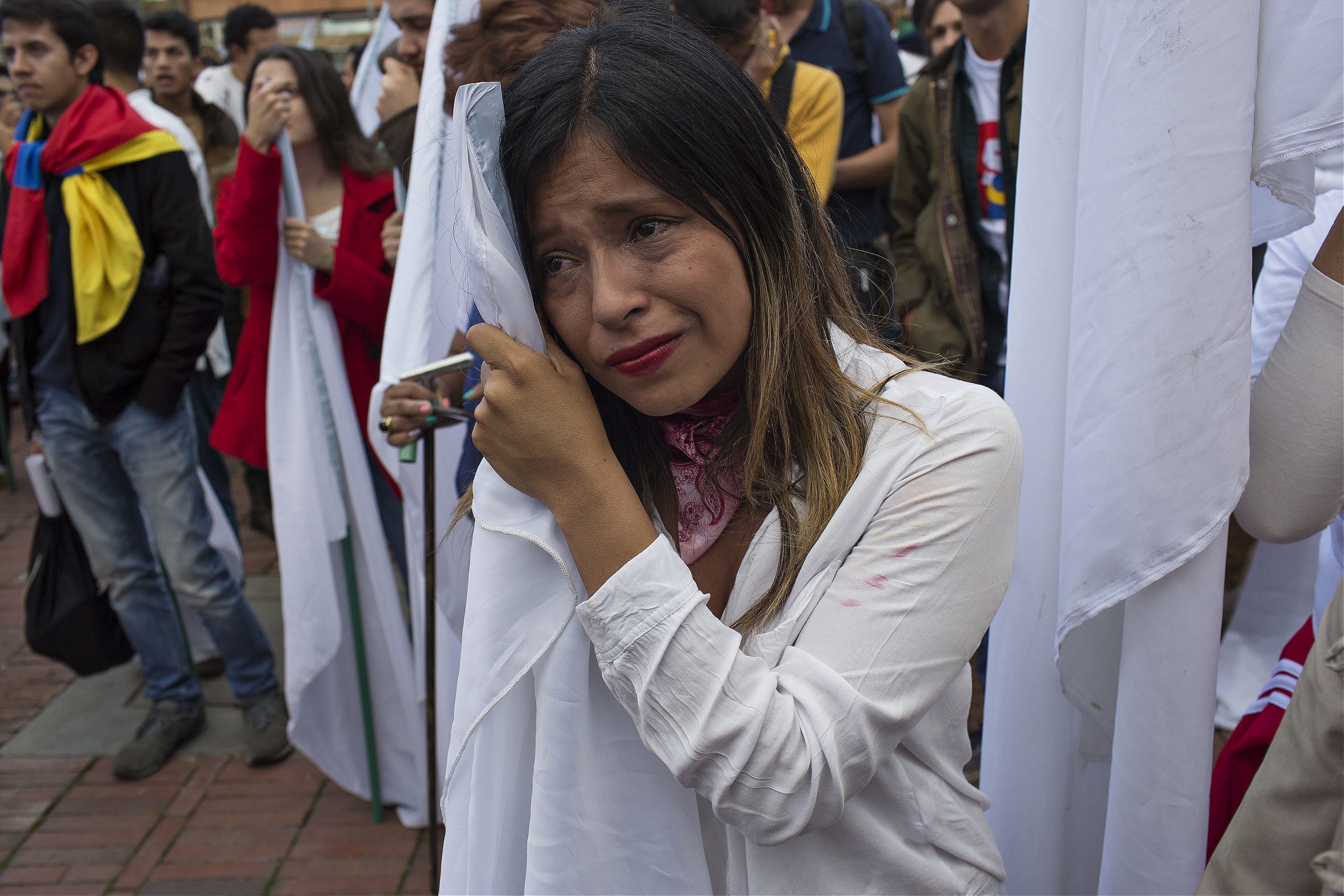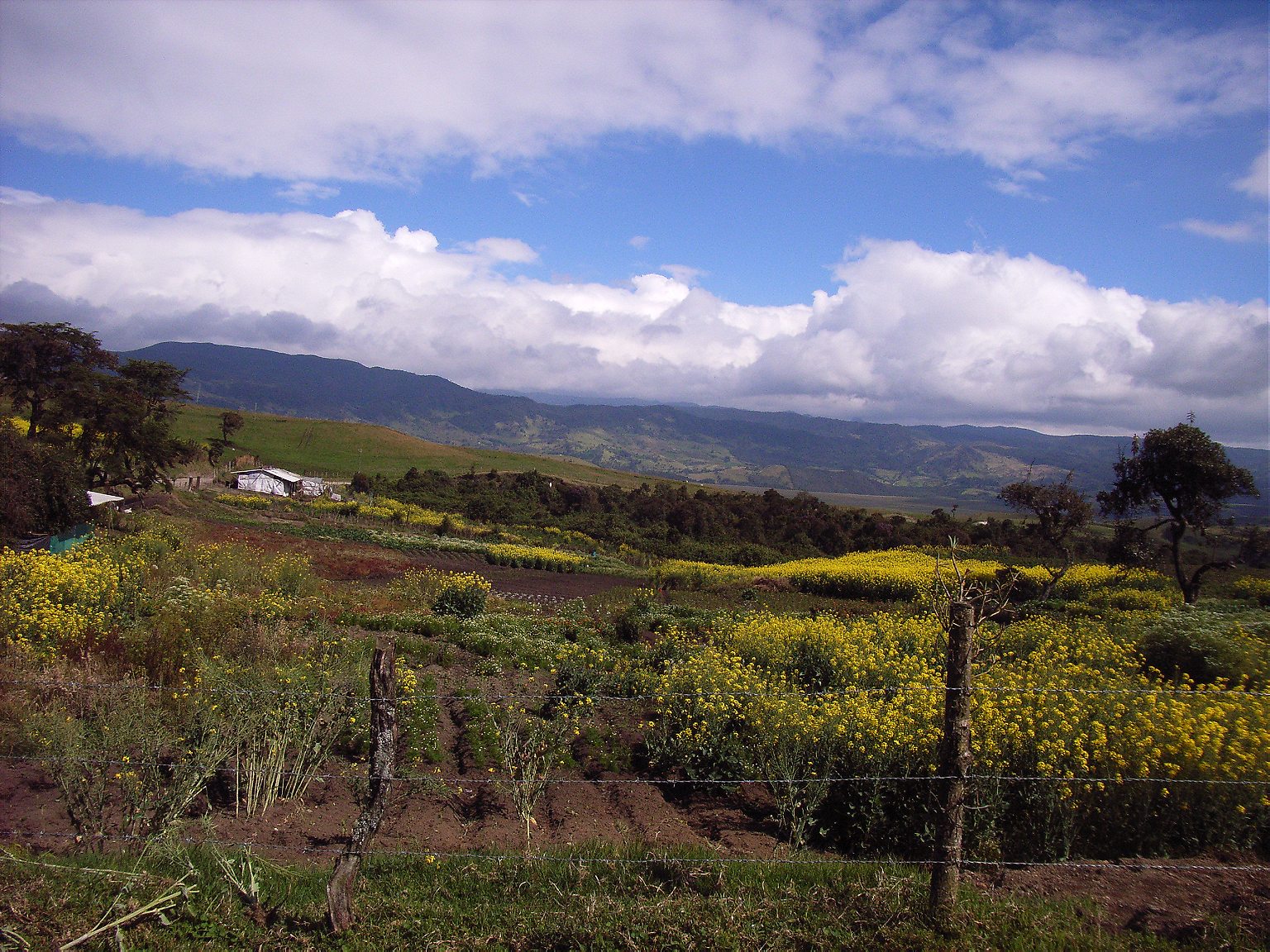After rejecting a historic peace deal, Colombia remains a nation divided.
On Sunday, Colombia voted to reject a historic peace deal, but this week is business as usual. Bogotá is gloomy. The sky is overcast, as it usually is during October. Political posters that have dominated the streets for the past month are already being replaced with concert advertisements. The traffic on Carrera 7 was slightly worse on Monday because of students protesting Sunday’s results, but few paid them any mind. While the political establishment is in crisis, most people are going through their day, largely indifferent.
I wonder if the reaction is the same elsewhere in the country. Last week, I was on assignment in Cauca, a region in western Colombia that was one of the hardest hit by the conflict between the Colombian state and the Armed Revolutionary Forces of Colombia (FARC) guerrilla group. I am Colombian and have lived here most of my life, but it was my first time in this part of the country. Growing up, it seemed like madness to visit a place I only heard about in headlines announcing guerrilla takeovers, bombs going off in the streets, routine kidnappings, and armed standoffs between the military and the guerrillas.
But today, everything is different. Since 2012, the Colombian government had been conducting peace talks with the FARC, which led to the guerrilla group announcing a ceasefire in December 2014. Though it was a shaky agreement at best, the talks continued and the Colombian government announced a bilateral ceasefire in August of this year. Finally, caucanos, the people who live here and have grown accustomed to living in fear, had some relief.
The proposed peace deal outlined that in exchange for a few economical, judicial, and political benefits, the guerrillas would disarm, confess their crimes, and be reintegrated into civilian life. This wouldn’t end all conflict in Colombia, but it would end a war that had been ongoing for 52 years. It would also dismantle the largest illegal armed group in Colombia and allow them to become a legal political party.

In Cauca, the choice was clear. Practically everyone I met was going to vote yes. I conducted a workshop in Santander de Quilichao—a town that had suffered FARC attacks as recently as August last year—with journalists working for regional outlets, some of them indigenous and some of them Afro-Colombian. All of them were voting yes.
They had many questions about how the peace deal would work. In particular, those who were indigenous were not completely convinced that the Colombian state, which has marginalized and lied to them for two centuries, was now going to deliver its promises of land reform and social justice included in the peace deal. But there was a wary hope in their eyes.
As part of the peace deal, 20 zones and seven camps were planned where FARC members could gather and disarm under international supervision. I made my way to one of them: a place called La Cominera, a mountainous section of a town called Corinto. To get there, I hired a driver named Javier, who hadn’t decided how to vote. He was from El Peñol, near the border with Ecuador, and had moved to find better job opportunities. He was angry that as part of the deal, the guerrillas would get 600,000 Colombian pesos per month (a bit less than the country’s minimum monthly wage) for a few months.
While Javier told me this and other opposition arguments (including wanting FARC members to receive more jail time and fear of a Communist takeover that would leave the country in dire straits, “just like socialist Venezuela”), we passed the town of Caloto. There, 20 members of the indigenous Nasa people were massacred by the Colombian Army for illegally occupying land in 1991. In August last year, FARC members broke their ceasefire and attacked the town’s police station.
After suffering so much violence from both sides, it was no surprise that they were looking for a change. The main street of Caloto was lined with white banners adorned with the town’s emblem proclaiming their support for the peace deal. It was the same in Corinto, where white flags and “yes” posters were plastered across windows.
THE MILITARY AND THE FARC USED TO SHOOT AT EACH OTHER FROM OPPOSING MOUNTAINS
In Corinto, I met with the local cabildo—a form of indigenous political organization—made up of the local Nasa population. They hooked me up with a Nissan Samurai to traverse the unpaved road to La Cominera, as well as a driver and “indigenous authorities” (a man and four teenagers) who would accompany me so I would not be denied entry. As we were climbing the steep hill, we saw the seemingly infinite valley that gives the nearby region the name Valle del Cauca. The region’s wealth is derived mostly from sugar cane, and I could see cane fields stretching toward the horizon. Earlier, one indigenous person told me he worried the peace deal was simply a land-grab by the government.
In La Cominera, however, there was a sense of unbridled hope. The indigenous peasants I met there—many of whom work on farms growing coffee or fruit, or sometimes coca and marijuana—confessed to me that they didn’t know exactly what was in the peace deal, only that the cabildo had told them to vote yes. But they knew that, since the peace talks began in Havana, their lives had been more peaceful.
The Colombian military and the FARC used to shoot at each other from opposing mountains, with La Cominera caught in the middle. Stray bullets routinely hit civilians, as had happened to a man I met named John, who lost the use of his left hand after being hit by a stray bullet. Even though he didn’t have the words for it, he also suffers from PTSD: he runs and hides under his bed every time he hears a helicopter approaching. But the shootings had stopped, and not just here. The year 2016 is reported to have been the most peaceful in Colombia since 1975, all thanks to the peace talks.
Of course, not everything is simple. Three weeks ago, the woman who owned the land being used for the FARC camp in La Cominera was stabbed to death. No one knows who did it, but the Army and local authorities occupied the town up until last week.
“I don’t understand who would want to keep this war going,” Ferney, a local indigenous man, told me as he grinded coffee. “I want to vote for peace. Only rich people who don’t know what war is will vote no.”

Back in my hometown of Bogotá, Colombia’s capital and richest city, I encountered an entirely different reality. “No” posters, the first I had seen in my time in the country, lined up walls, usually covering up “yes” posters that had been posted previously. People in the streets wore “no” shirts and repeated the mostly mendacious arguments made by former President Álvaro Uribe Vélez, a staunch opponent of the deal. He claimed that his Centro Democrático party could reach a better deal and that the current peace deal amounted to “a handover of the country to the FARC.”
Most of my friends and family were voting yes. But the rising tide of “no” outside my bubble started to seem inevitable. Those I met who were planning to vote no seemed stuck in an abstract search for justice: more jail time, more fiscal penalties, less political benefits, more measurable punishments. What the peace deal offered instead was perhaps too hopeful: truth, reparation, and reconciliation, all much more difficult to measure, but necessary for a new, more peaceful society. Yet, many remained unmoved: the hopes of people living far off in the countryside seemed irrelevant here.
When I told my stepmom about what I had heard in Cauca, she said, “Of course they are voting yes. They are all FARC members there.” Those suffering were not fellow Colombians, but enemies to be defeated. As I walked around Bogotá on voting day, I heard similar things. “They [FARC members] deserve nothing!” a guy told me when I asked him why he was voting no. “We want peace, but not peace like this!” However, no one seemed to know what a different peace would look like.
The results that day started to pour in quickly after 4 p.m. on Sunday. At first, “yes” had a slight advantage, but it was dwindling with each report. By 5 p.m., news reports gave “no” a slight edge. I heard a woman in a nearby apartment cry out with joy as the radio announced that no was in the lead. It broke my heart.
MOST PLACES THAT HAD FELT WAR FIRST-HAND VOTED YES
In the end, “no” won with 50.21 percent of the vote, less than 54,000 votes in a country where 34 million could vote, but only 13 million did. (I, like many others, couldn’t vote because I was registered in a different country and there was no system in place to change my registration).
No one knows what’s next. The current peace deal was invalidated by this vote. President Juan Manuel Santos invited the “no” promoters to talk next steps. And though both the government and the FARC said that the bilateral ceasefire still goes, not much more is known about our future. In his intervention on Sunday, Uribe seemed more interested in starting a campaign for the presidential election of 2018 than about figuring out what will happen with the peace talks.
Every town in Cauca voted yes. In Corinto, where I had been, 69.22 percent voted yes. In Bojayá, a town in the Chocó region where the FARC killed 120 civilians by detonating a bomb inside a church in 2002, 95.78 percent voted yes. Most places that had felt war first-hand voted yes, although some, understandably, were not quite ready to forgive just yet.
Now the road ahead looks beyond bumpy. Colombian institutions that were getting ready to implement the peace deal will take a while to redirect their efforts. A new peace deal is certainly possible, but uncertain. But, even more worrying, the two countries that voted on Sunday are still a long way from figuring out how to live together.
Top image: A man reads a newspaper announcing the results of the referendum in Cali, Colombia, on October 3, 2016. Photo by: Luis Robayo/AFP/Getty Images.